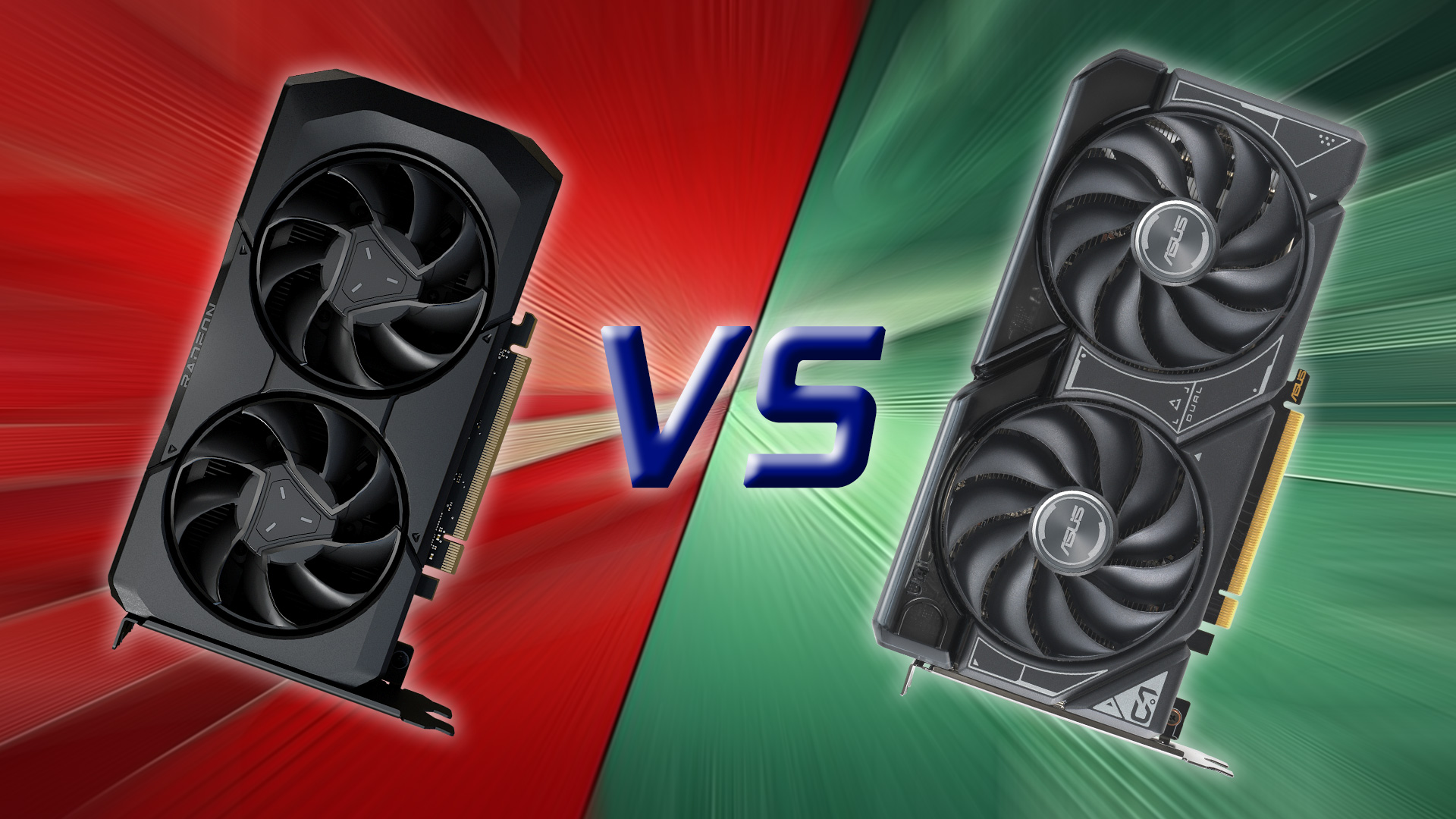
The RTX 4060 and RX 7600 represent two of the most important GPUs on the market today. Both GPUs fill out the extremely popular $250–$300 price bracket that, if we’ve learned anything from Steam’s Hardware Survey, are the most desirable price point for PC gamers. The best graphics cards might range in price from $150 to as much as $1,500 in theory, but far more people are willing to fork over $300 instead of opting for a high-end or extreme performance graphics card. In this faceoff, we'll discover which GPU is the best option.
The Nvidia RTX 4060 provides the lowest entry point into its Ada Lovelace RTX 40-series GPU product stack right now. When it arrived last year, it arrived with a positive twist by being $30 cheaper than the previous generation RTX 3060 12GB. $30 might not seem like much, but it makes the RTX 4060 the first and only RTX 40-series GPU (so far) to undercut its predecessor in price. We commended the RTX 4060's excellent power efficiency, though we weren't as pleased with the regression to a 128-bit bus and 8GB of memory, noting that in practice the GPU feels more like a replacement for the RTX 3050 8GB than it's beefier 3060 sibling.
The AMD RX 7600 is also the lowest SKU in Team Red's product stack. The RX 7600 had a strange launch, as AMD originally priced the GPU at $300, but almost immediately after Nvidia’s RTX 4060 announcement (which included the card’s $299 MSRP), the official launch price dropped to $269 to better compete with Nvidia. It was a necessary price cut as otherwise the matchup would have been decidedly one-sided, and we noted the rather lackluster performance in our review. AMD barely moved the needle in the performance department compared to the prior generation RX 6650 XT, and even now the RX 7600 feels like a glorified RDNA 2 card rather than a true budget-mainstream successor to the RX 6600.
To find out how the RTX 4060 and RX 7600 stack up, we'll look at performance, price, features, technology, software, and power efficiency — in order of generally decreasing importance. Then we'll render a verdict on this mainstream / budget shootout — sadly, both AMD and Nvidia have effectively abandoned the true budget range of dedicated graphics cards this generation.
RTX 4060 vs RX 7600: Performance
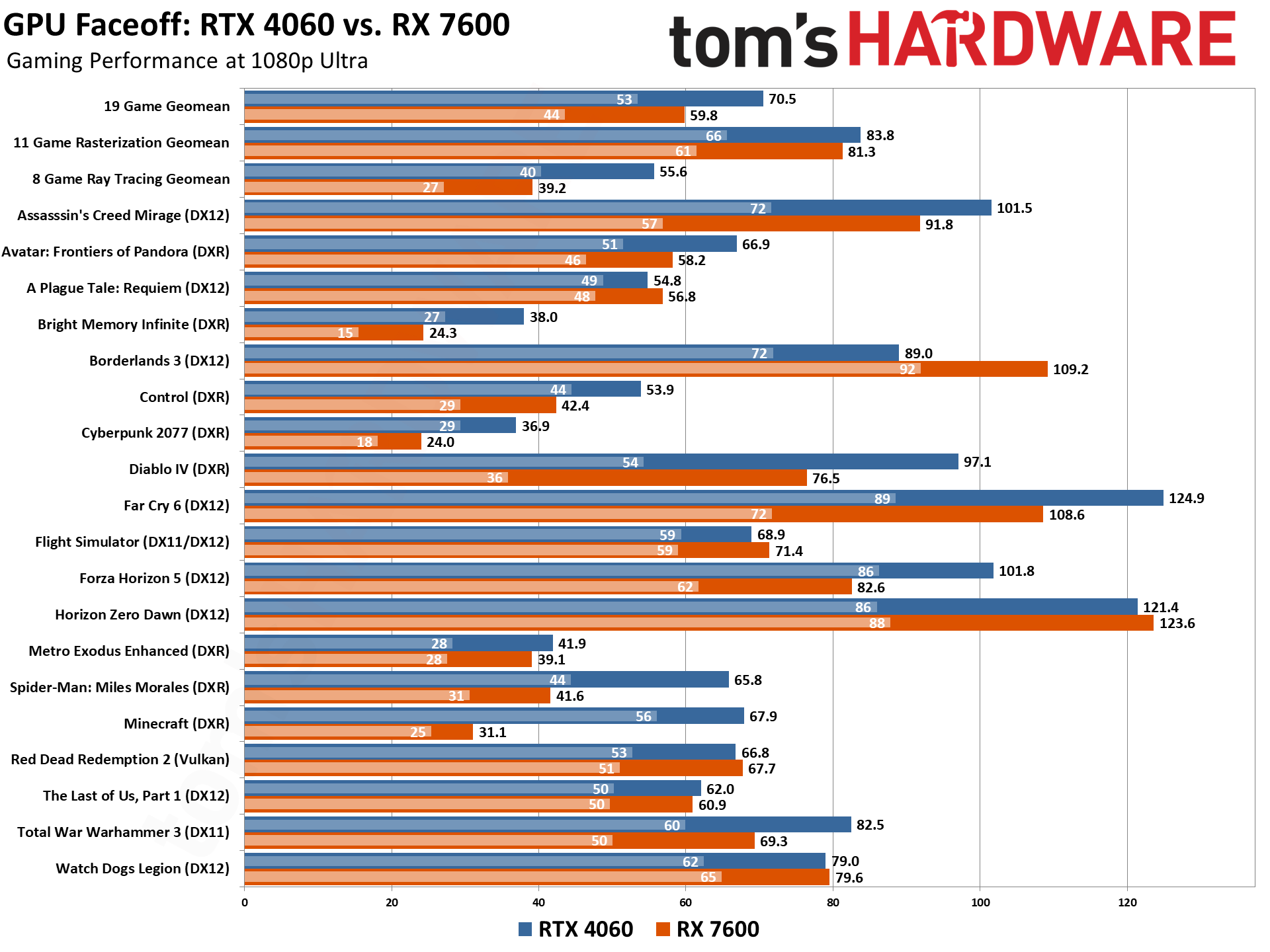
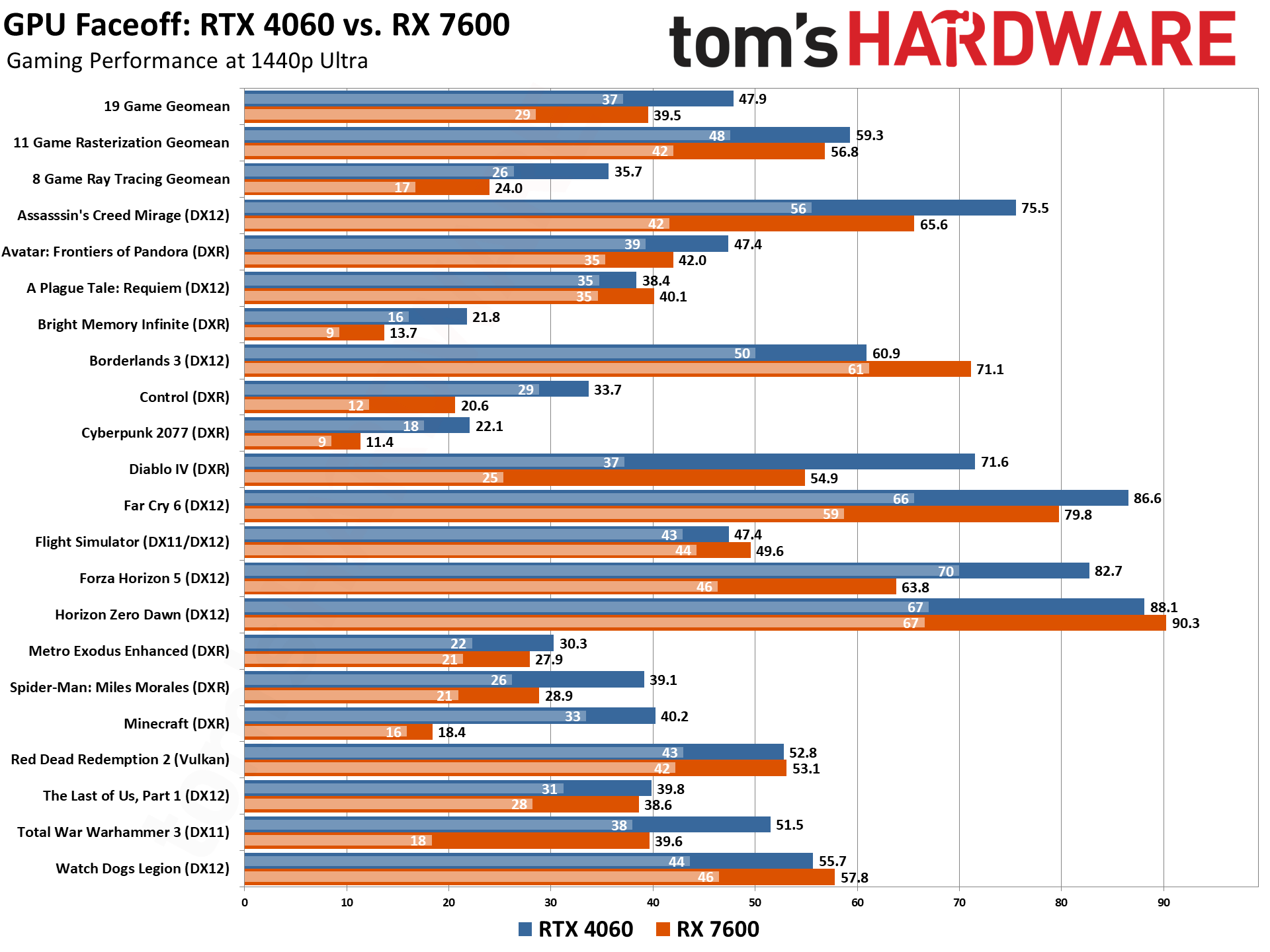
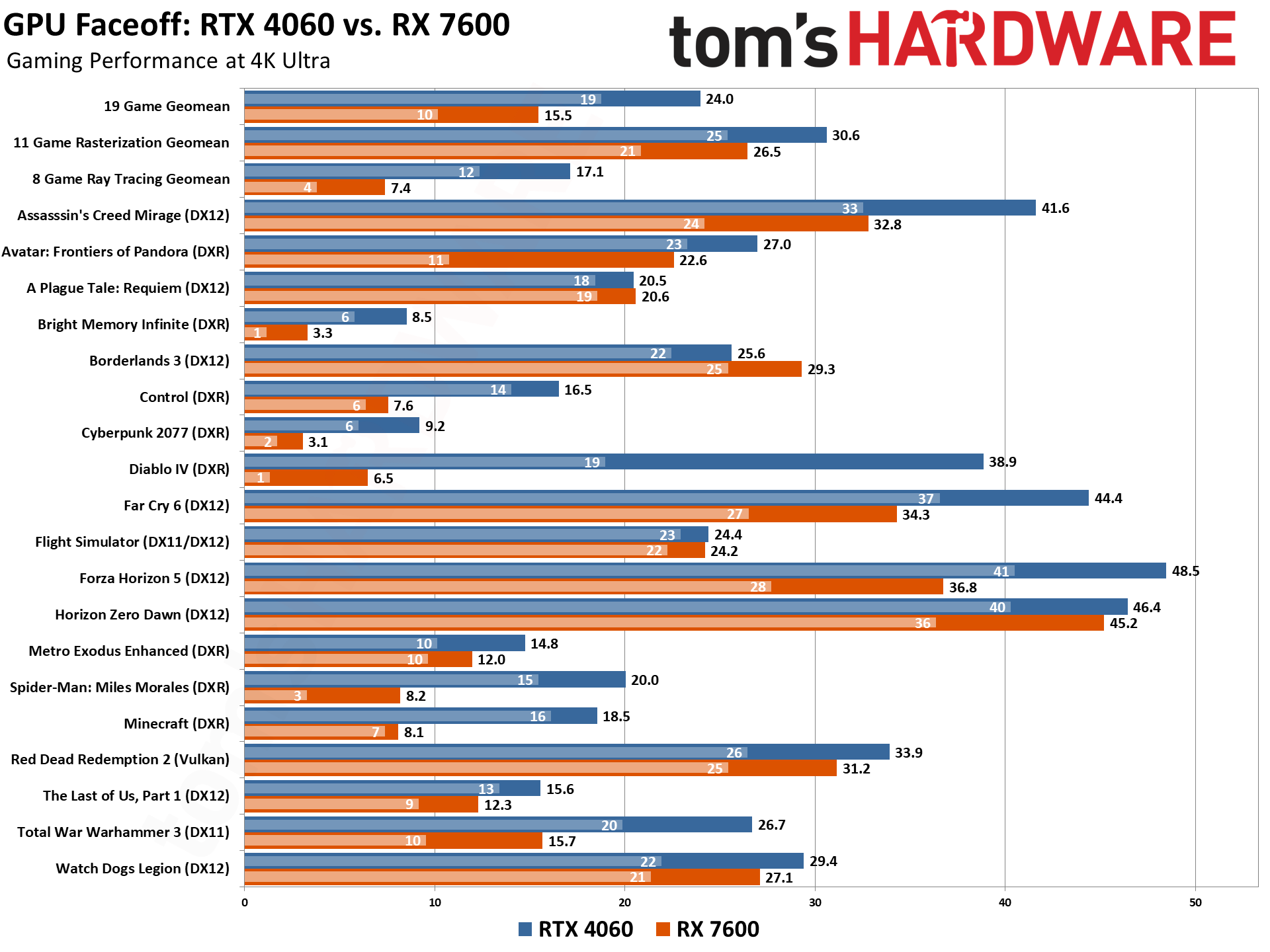
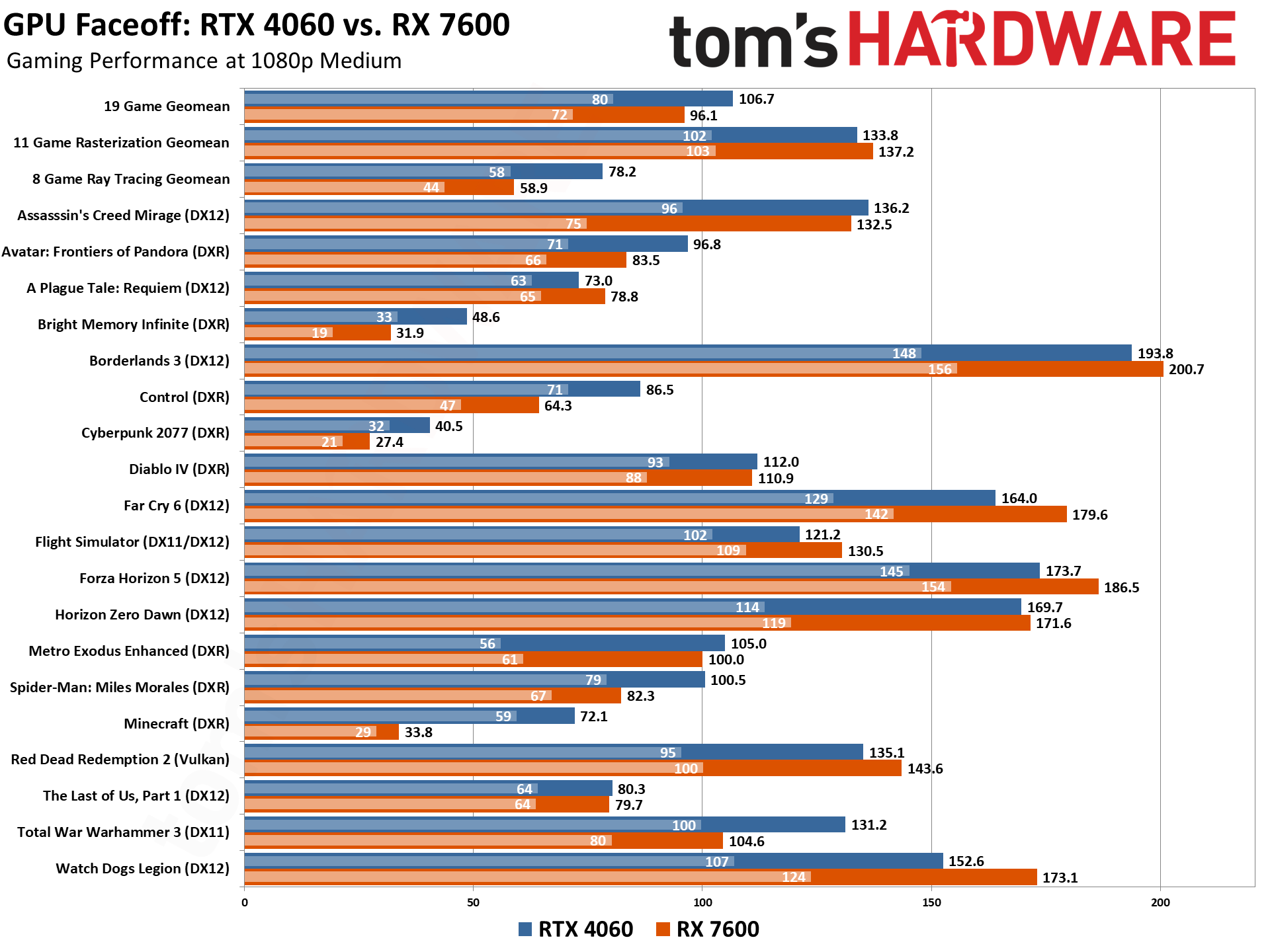
The RTX 4060 wins by a landslide in our gaming benchmarks. Nvidia's GPU is 18% faster in our 19-game geomean result at 1080p ultra, and 42% faster in our ray tracing 8-game geomean. The only game selection where the AMD GPU showed competitive strength was in our 11-game rasterization geomean, but even here the Nvidia card edges the AMD GPU by 3%.
The performance delta only gets worse for the RX 7600 as resolution increases. At 1440p, the RTX holds a lead of 21% in our 19-game overall score, with a 49% lead in ray tracing performance and a 4% lead in rasterization results. Neither GPU compes close to clearing 60 fps across our entire test suite at 1440p, but most of the games remain quite playable — and those that don't (like Cyberpunk 2077 and Bright Memory Infinite) will greatly benefit from DLSS (or FSR 2) upscaling.
4K ultra gaming isn't the primary use case for GPUs of this caliber, and it shows. While the RTX 4060 takes a massive 55% lead overall, with a 132% victory in ray tracing performance and a 16% lead in rasterization games, only about a third of the games can even break 30 fps at our test settings on the RTX 4060 — and only five games break that barrier on the RX 7600. Obviously, native 4K gaming isn’t a critical resolution for these mainstream GPUs, but we include the results for consistency's sake, as well as to show just how much graphics horsepower 4K gaming requires these days.
The one bright spot for AMD's RX 7600, if you can call it that, comes with our 1080p medium test results. This represents the opposite end of the spectrum from 4K ultra, and just about everything should run well — though ray tracing as usual can still tax these mainstream cards. Here the RTX 4060 'only' wins by 11% overall, with a 33% lead in ray tracing games. But the RX 7600 does eke out a 3% lead in the rasterization test suite.
Diving into the individual game results, most of the games favor the Nvidia RTX 4060 GPU. That's unsurprising, particularly when nearly half of our benchmarking suite consists of ray tracing titles. However, when we look at rasterized-only games the RX 7600 remains competitive — especially in titles that are AMD-sponsored.
In our testing, focusing on the 1080p ultra results, Borderlands 3 is the only major AMD victory. It's an AMD-sponsored game that has always favored Team Red hardware, and it runs 23% faster on the RX 7600 than the RTX 4060. A Plague Tale: Requiem and Flight Simulator also give AMD just under a 4% lead, with several other games that are effectively tied. Outside of the ray tracing games, which universally favor the 4060 by anywhere from 7% (Metro Exodus Enhanced) to 118% (Minecraft with full path tracing), the rasterization games that more strongly favor the RTX 4060 include Forza Horizon 5 (23%), Total War: Warhammer 3 (19%), Far Cry 6 (15%), and Assassin's Creed Mirage (11%).
Based purely on performance, even though both GPUs come equipped with 8GB of VRAM on a 128-bit memory bus, Nvidia clearly comes out as the overall winner for games.
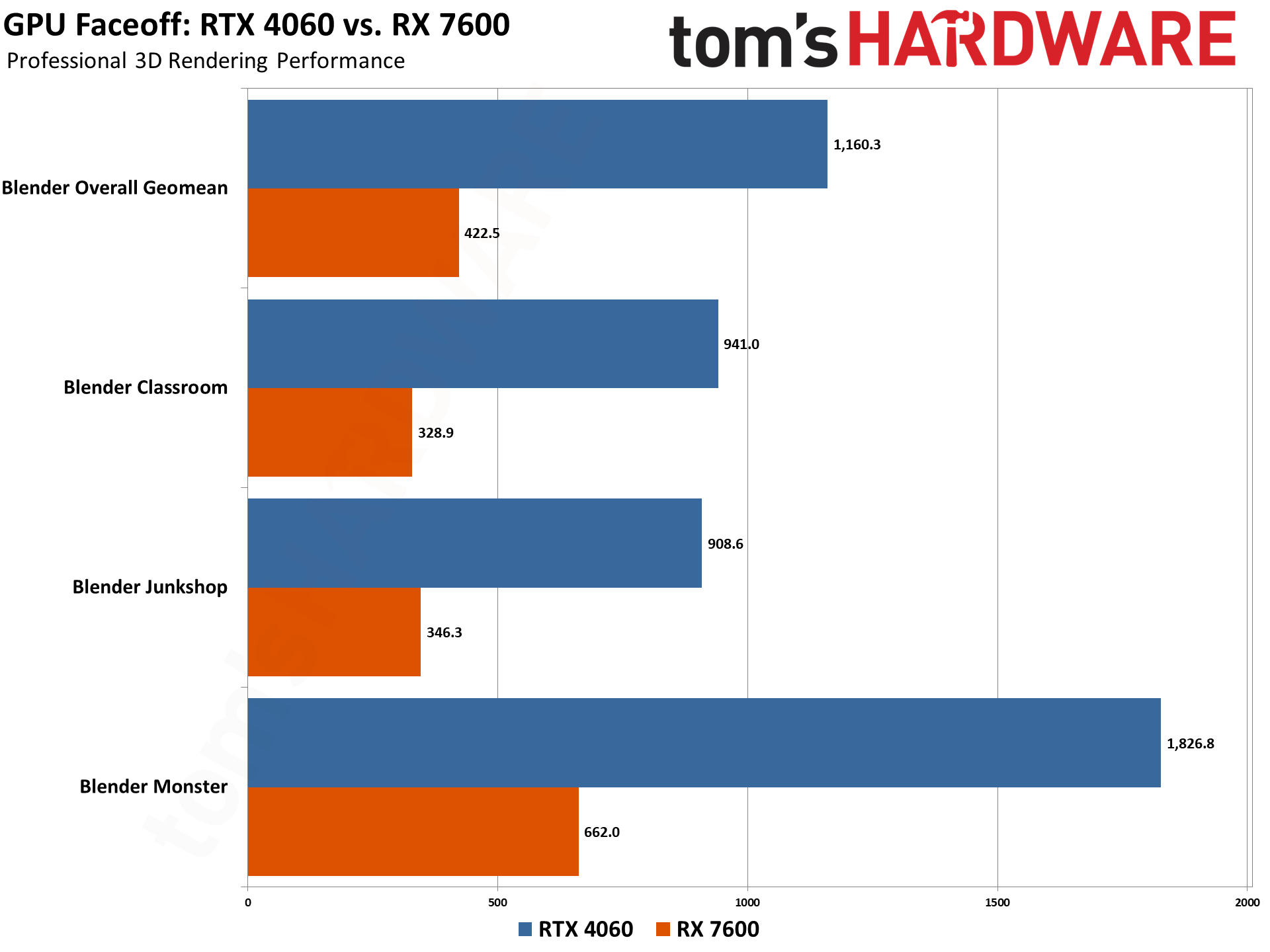
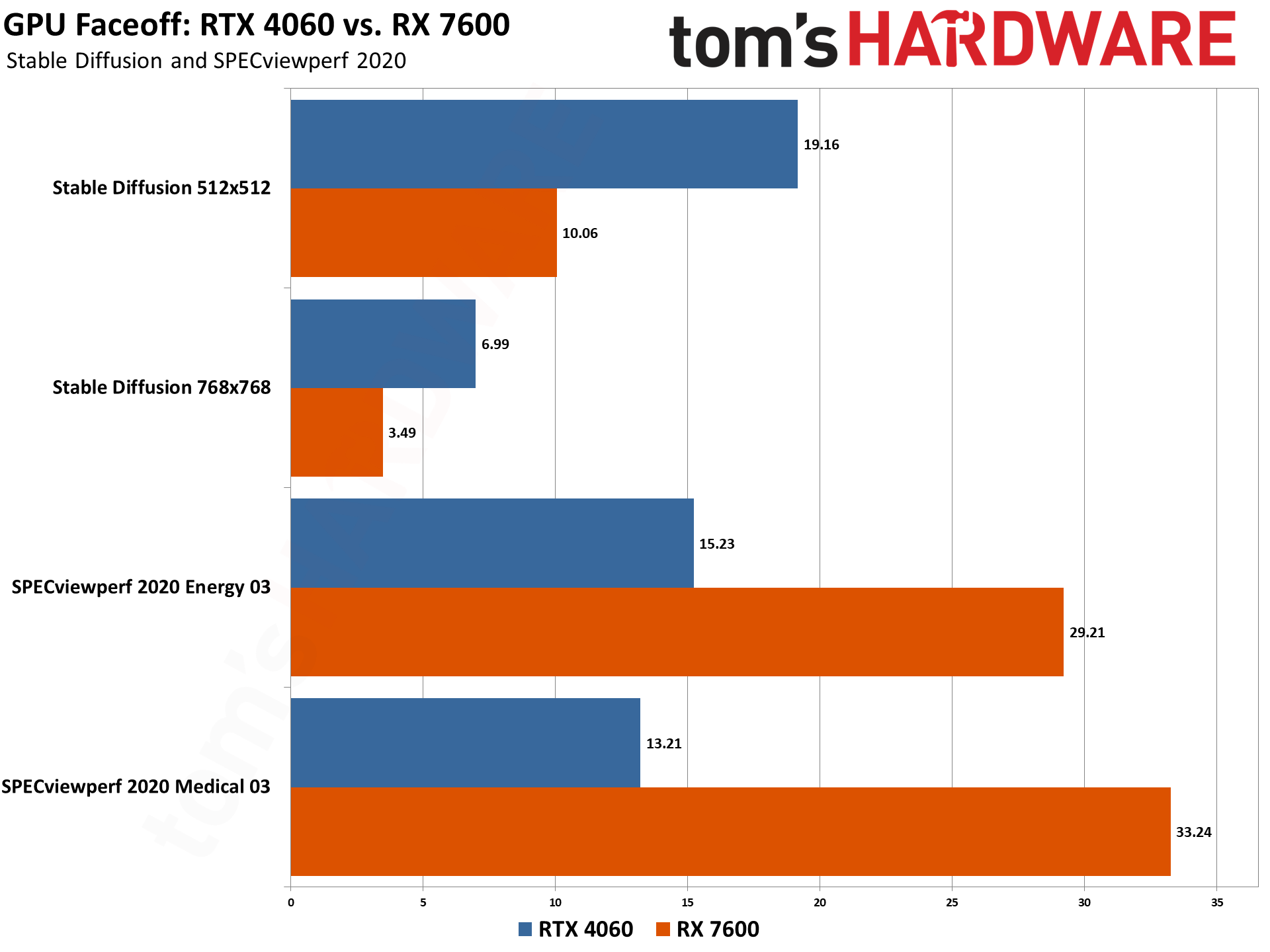
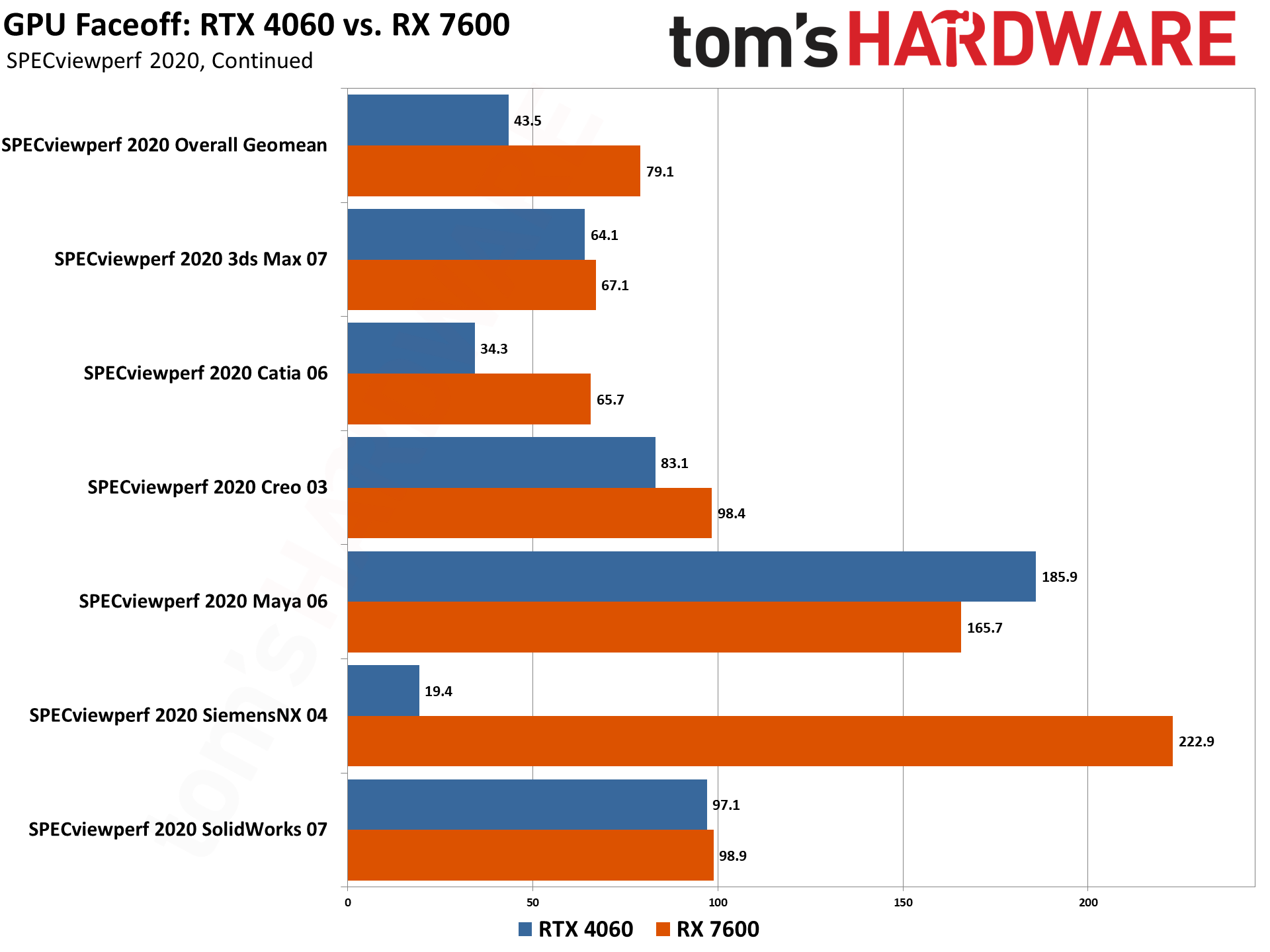
What about outside of games, like in professional and AI workloads? Here the RTX 4060 runs away from the RX 7600 in our Stable Diffusion and Blender benchmark results. It's about double the performance in Stable Diffusion image generation, and close to three times as fast (175% faster) in Blender 3D rendering.
SPECviewperf 2020 v2 does turn the tables, however. The RX 7600 comes out 82% faster in our overall geometric mean score (which gives equal weighting to each of the eight sub-tests). The only app that slightly favors the RTX 4060 is Maya 06, where Nvidia's GPU comes out 12% faster than the 7600. But professional and even AI workloads generally don't represent the most likely use cases for mainstream GPUs, so we weight the gaming performance much heavier.
Overall Performance Winner: Nvidia RTX 4060
Overall, the RTX 4060 easily wins the performance battle. At worst (1080p medium), the RTX 4060 matches the RX 7600 in rasterized games. Everywhere else, it starts to open up a decently large gap. As mainstream GPUs, 1080p ultra represents the most likely use case, and the 4060 can smoothly run games with ray tracing where the RX 7600 cannot. 3D rendering and AI also greatly favors the Nvidia GPU, with the latter being arguably more important in the long term. SPECviewperf does give AMD it's sole victory, and frankly it doesn't count for much as most professionals will use faster professional GPUs. The wider support for DLSS, along with its superior image fidelity, only serve to widen the performance gap.
RTX 4060 vs RX 7600: Price
While performance clearly favors the RTX 4060, RX 7600 wins hands down on pricing, at least when looking at the raw dollar cost. AMD officially set the launch price of the RX 7600 at $269, but street prices currently start at $259, with six different AIB (add-in board) partner cards available at that price.
Nvidia hasn't dropped the price on the RTX 4060 — officially or unofficially — so it's still mostly a $299 card. There are some cheaper cards, like the PNY RTX 4060 Verto that currently sells for $279 from Dell, but the next closest card is the $293 MSI RTX 4060 Ventus 2X. Generally speaking, the 4060 typically starts at $284 based on what we've seen over the past six months, with the occasional short-term sale.
But it's not strictly a matter of pricing. Again, the Nvidia RTX 4060 tends to be about 18% faster than the RX 7600 at the resolutions and settings that matter most. Based on bang for the buck (FPS per dollar spent), the RTX 4060 tends to come out ahead of the RX 7600. Also worth noting is that power use tends to be 30W lower on the Nvidia card, so depending on how often you play games during a month and how much you pay for power, that could also work out to several dollars per year.
Price Winner: AMD RX 7600
If you're looking at price as a value metric, Nvidia might technically get the win here, but for a lot of gamers, it's about a $30 price difference in favor of AMD's RX 7600. Consider your particular needs before making a final decision, and the other categories inevitably impact the raw price matchup — like electricity costs over time. At current prices, however, the RX 7600 gets the win as the less expensive card, by at least $20 at the time of writing.
RTX 4060 vs RX 7600: Features, Technology, and Software
When it comes to specifications, the RTX 4060 and RX 7600 look relatively similar in several key areas. Other areas seemingly favor one or the other GPU, but in practice the paper specifications don't always tell the full story.
Both GPUs come with a 128-bit memory interface and 8GB of memory, which generally gets the job done at this price point. We're less concerned with a 128-bit interface and 8GB on a $300 (or less) graphics card than on the RTX 4060 Ti. However, the 128-bit interface and 8GB of VRAM do give the RX 7600 more difficulty than on the 4060 — note how some games seem to run out of VRAM on AMD's GPU while the Nvidia card still does okay, which is particularly noticeable at 1440p and higher where memory bottlenecks come into play.
This difference can be attributed to Nvidia’s superior memory compression and perhaps drivers. In general, we find that Nvidia GPUs perform like an AMD GPU with approximately 2GB more memory. In the case of the RTX 4060 8GB, its memory system behaves like a RX 7600 with 10GB of memory. It's not a perfect approximation, but there are clearly games in our test suite where the RTX 4060 does better with the same amount of VRAM and slightly less memory bandwidth.
Interestingly, the RX 7600 seemingly offers higher raw FP32 teraflops than the RTX 4060. That's because each of the 32 Compute Units on the RX 7600 has 64 shaders, but can also do twice as many FP32 operations per cycle. That gives AMD's GPU a theoretical 21.7 teraflops versus Nvidia's 15.1 teraflops... but outside of Borderlands 3, we never really see such a weighting in real-world performance.
AMD's RX 7600 also offers 64 ROPS (Render Outputs) versus the RTX 4060's 48 ROPS. And it has 32MB of L3 Infinity Cache compared to 24MB of L2 cache. The theoretical advantage points to AMD, but the practical advantage seems to favor Nvidia.
There are areas where AMD falls far short of Nvidia as well. Besides superior ray tracing performance, the RTX 4060 has 121 teraflops of FP16 compute for AI workloads, and double that with FP8 inference. The RX 7600 only has 43 teraflops of FP16 throughput by comparison. The combination of Nvidia’s latest RT cores plus its fourth generation tensor cores are hard to understate. Those features working in tandem allow the RTX 4060 to deliver playable framerates in full path-traced games such as Minecraft and Cyberpunk 2077 Phantom Liberty. The RX 7600 often comes up short, and AMD still treats ray tracing and AI more as an afterthought than a primary feature.
Nvidia and AMD have competing upscaling solutions: DLSS and FSR, respectively. DLSS generally delivers superior image quality, but AMD’s FSR has the advantage of being able to work on any GPU — not just AMD hardware. Both companies also offer frame generation technology, but Nvidia accomplishes this in hardware via its Optical Flow Accelerator while AMD does all the computations on shaders. AMD's framegen tends to have more artifacting, and frankly neither solution has proven to be a must have feature.
On the software side, there are a few things worth mentioning. While the drivers are relatively equal between Nvidia and AMD, Nvidia does have more software solutions than AMD, particularly ones that are AI-focused. These include Broadcast, ChatRTX, Reflex, and Video Super Resolution, and these tend to work well and integrate better than AMD's alternatives (where such things exists).
Features, Technology, and Software Winner: Nvidia
The RTX 4060 wins overall for its superior features and technology. It's not difficult to see why many people gravitate toward Nvidia hardware, even at higher prices — there's a less vocal majority of gamers that simply won't bother looking at anything other than GeForce cards. That sort of vendor lock-in can stifle innovation over the long haul, but so far Nvidia has proven more willing to go out and create new software and hardware solutions.
Power Consumption
RTX 4060 vs RX 7600: Power Efficiency
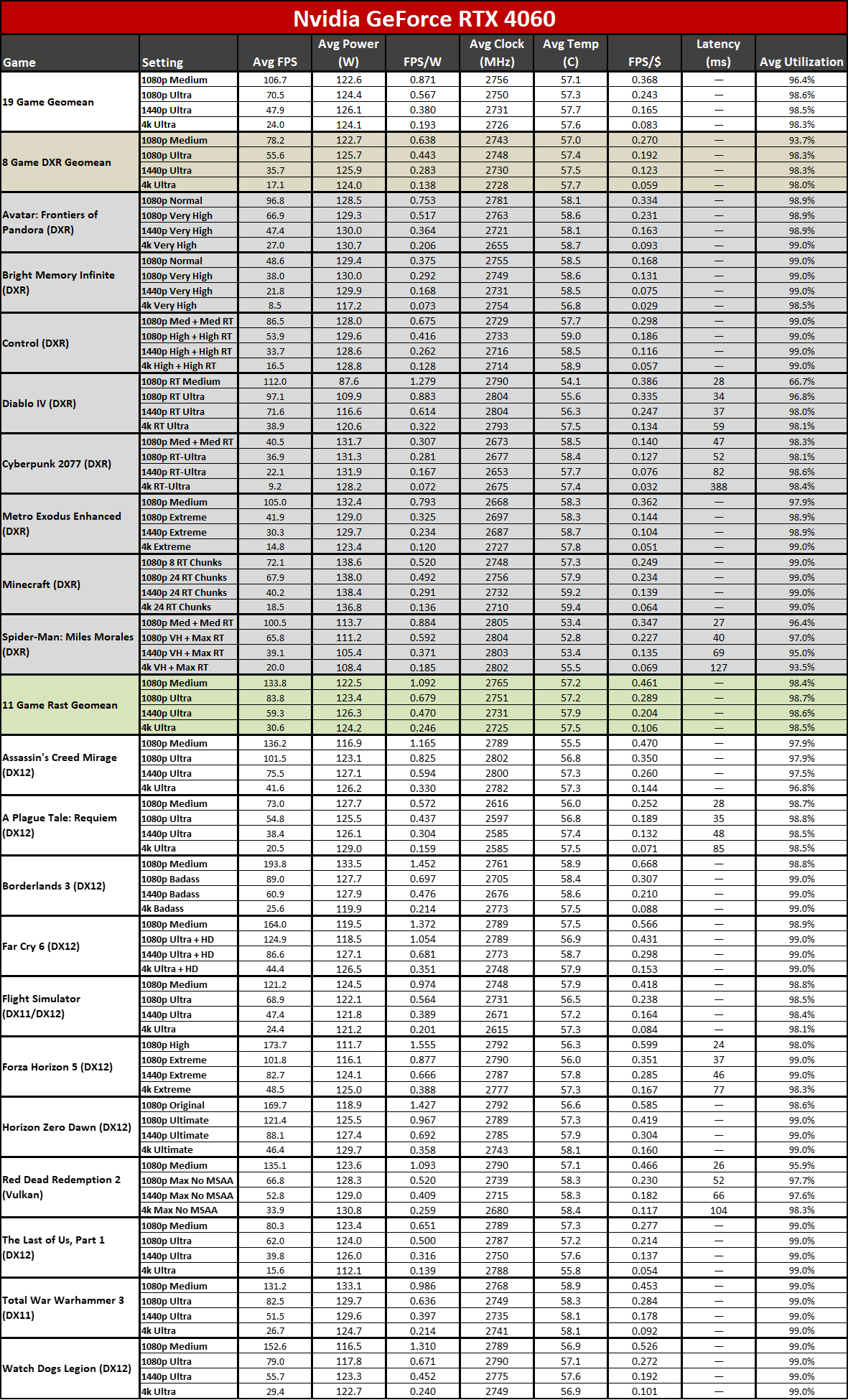
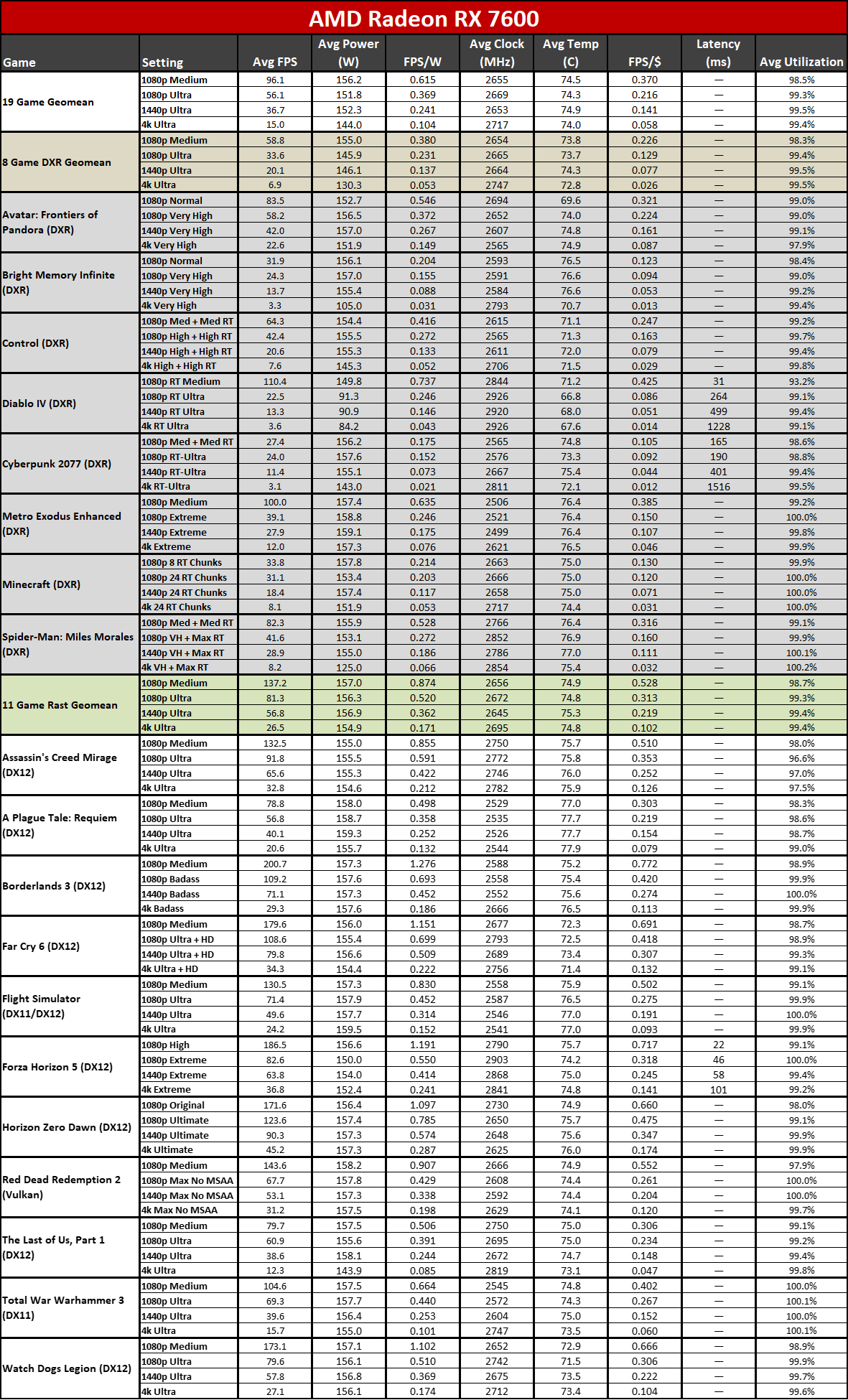
Power, as hinted at earlier, massively favors the RTX 4060. It's rated for 115W TGP (Total Graphics Power), while AMD's RX 7600 has a 165W TBP (Total Board Power) rating. The two are reasonably comparable measurements, and in our full test suite, the RTX 4060 — even with a factory overclocked Asus card — typically draws 25–35 watts less juice. Superior performance with better power efficiency ends up as a double whammy.
The RTX 4060 delivers roughly 20–25 percent higher power efficiency thanks to Nvidia’s Ada Lovelace GPU architecture. The RTX 4060 pulls a measly 125W on average, while the RX 7600 pulls roughly 150W on average. The RTX 4060’s power consumption is also 45W lower than its RTX 3060 12GB predecessor.
Power consumption doesn’t really fluctuate as much with these lower tier GPUs across different resolutions and settings. Comparing 1080p medium, 1080p ultra, 1440p ultra, and 4k ultra power numbers, the RTX 4060 uses anywhere between 122 to 126 watts across our test suite. Among the individual games, the lowest power (at 1080p RT Medium in Diablo IV) is 87.6W, but the next-lowest power use was around 110W; maximum power use (again, for a factory overclocked card) comes in at 138.6W.
The RX 7600 has average power use of 156W at 1080p and 1440p, but that drops to 145W at 4K — mostly thanks to memory congestion and sometimes extremely poor performance. Outside of 4K results, the lowest average power while gaming on the RX 7600 measures 150W, and the highest power use comes in at 159.5W.
Power Efficiency Winner: Nvidia
Factor in the superior performance of the RTX 4060 and its lower power use, and overall power efficiency (FPS/W) ends up 42% higher at 1080p medium, 54% higher at 1080p ultra, and 58% higher at 1440p ultra — and 87% higher at 4K ultra, not that we'd suggest using either card at such settings in modern games.
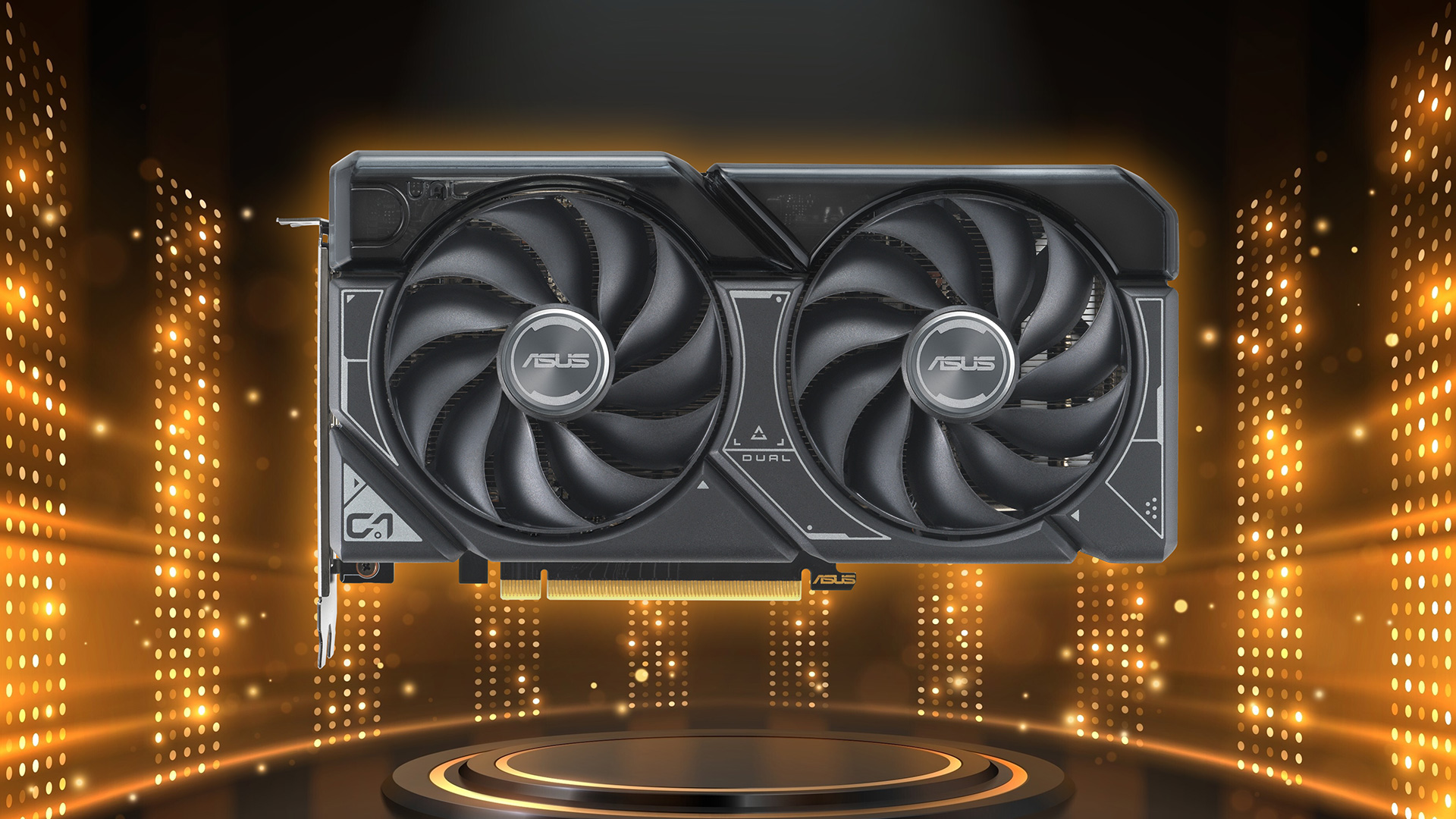
RTX 4060 vs. RX 7600 Verdict
The RTX 4060 and RX 7600 can both handle most games at 1080p and medium to high settings. They'll get the job done without breaking the bank, in other words. However, the RTX 4060 clearly ranks as the superior option, with better overall performance, features, and power efficiency. It's definitely worth spending the extra $20–$40 for a typical RTX 4060 compared to the RX 7600, even if AMD's card doesn't cost as much out the door.
AMD generally competes with Nvidia by offering more memory and memory bandwidth at most levels, but that doesn't happen with the RX 7600. The cuts are deep enough that some of the shortcomings really start to matter, and the RX 7600 barely offers much in the way of tangible performance benefits over the previous generation RX 6650 XT.
We don't hate the RX 7600, though it did rate as one of the top five worst AMD GPUs of all time — that's largely due to the lack of tangible performance improvements. Many would say the RTX 4060 doesn't improve much over the RTX 3060 either, but that's actually not quite true. Across our gaming tests, the 4060 beats the 3060 12GB by about 20%. That's not a massive improvement, but coupled with the reduced price, new features, and lower power use, it's at least tolerable.
Every dollar counts when you're looking at a budget GPU, and here you're better off spending slightly more for Nvidia's RTX 4060 than pinching pennies and opting for the RX 7600. Frankly, AMD probably needs to discount the RX 7600 by another $30 to make it competitive. It needs to clearly undercut Nvidia's pricing by a big enough margin to overcome the features and power deficits along with the performance deficit.
As it stands now, the RTX 4060 is the better card in virtually every category. If you're dead set on not buying an Nvidia GPU, you'd be far better off opting for AMD's previous generation RX 6750 XT at $299, which at least manages a substantial win in rasterization performance, even if it's over three years old now. But that's perhaps a faceoff for another day...







